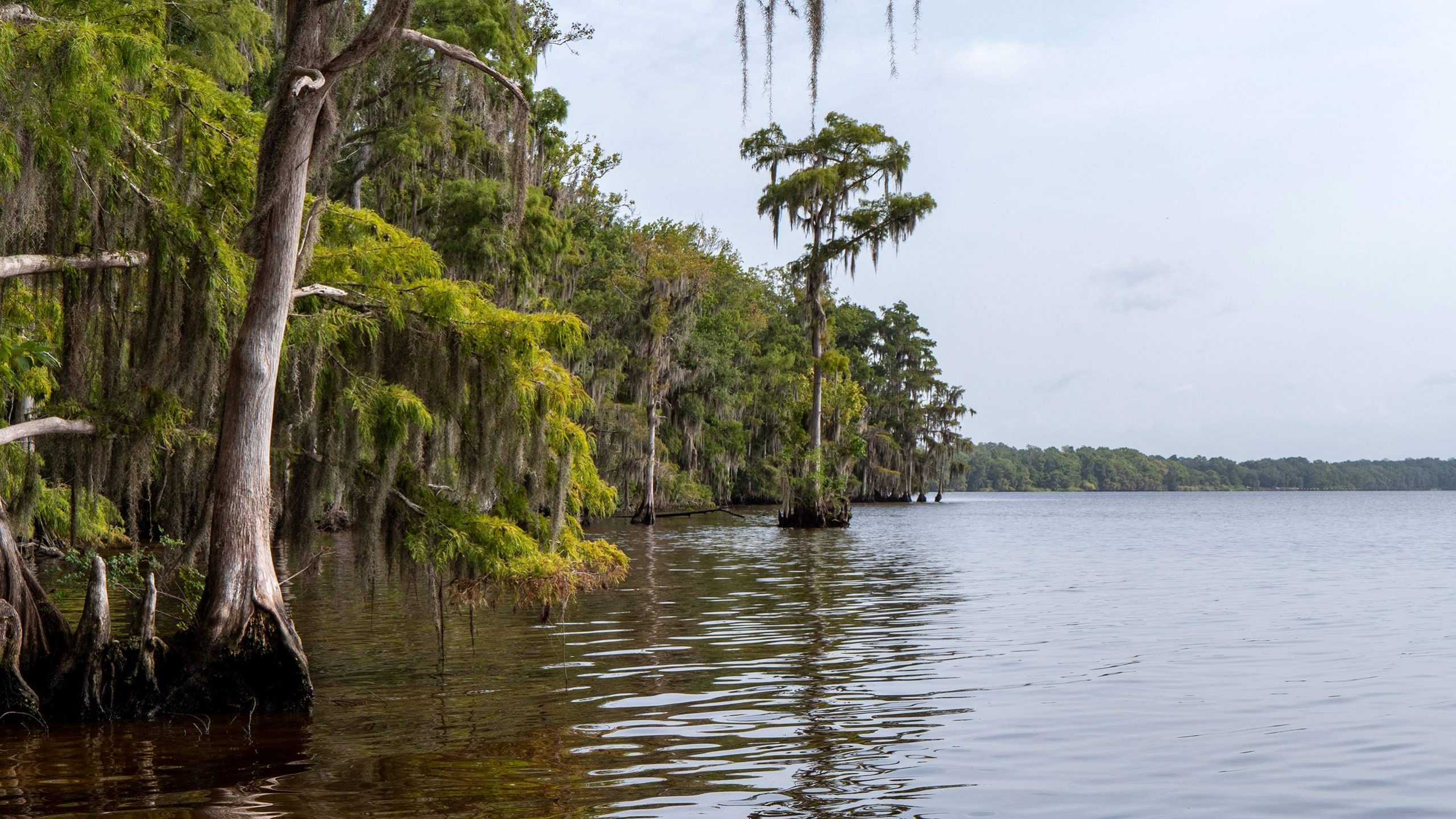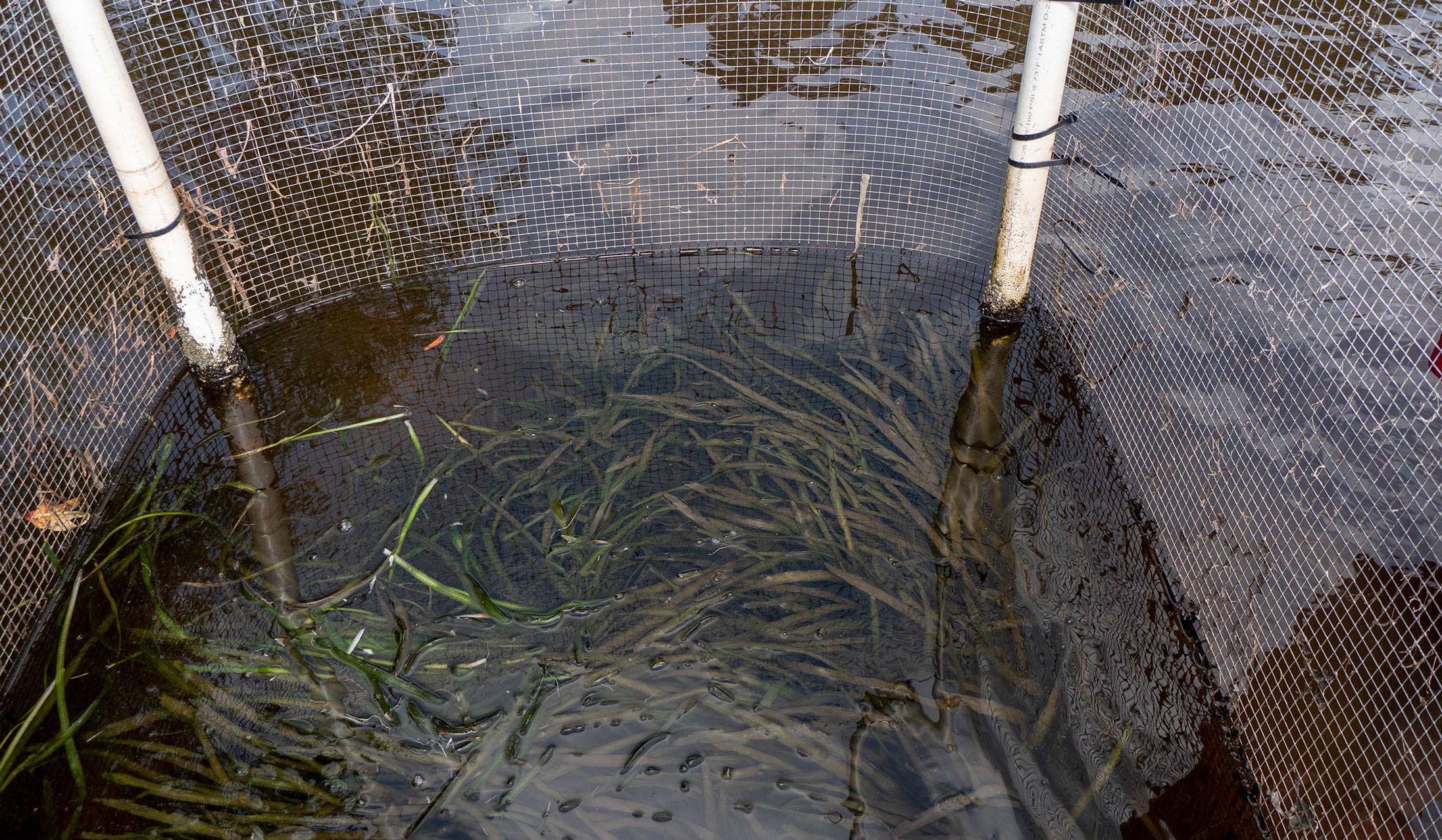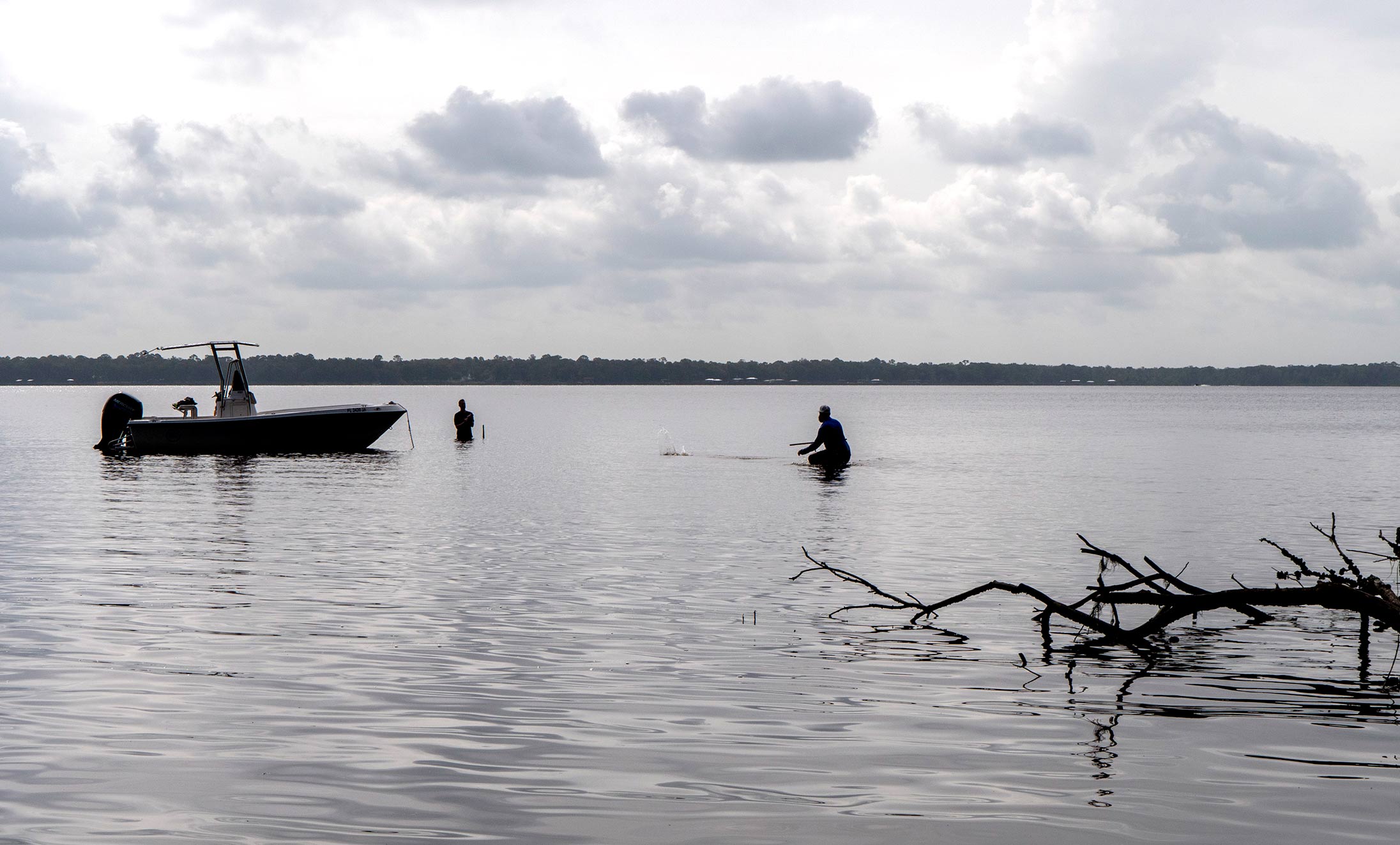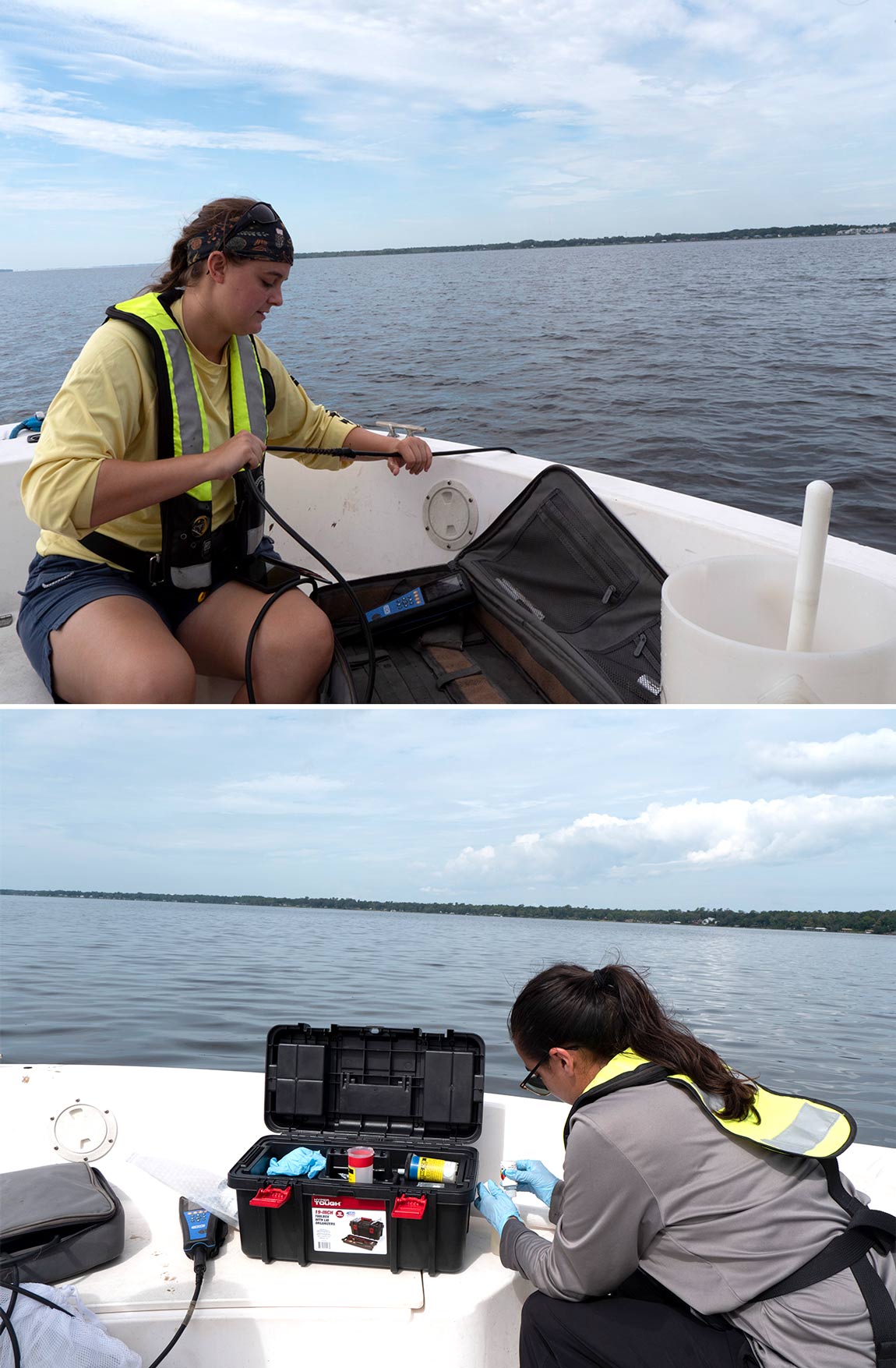A Journey on the St. Johns River: Where the river meets the ocean
This is the sixth and final part of a series about the St. Johns River. Each installment explores one of the river’s three distinct basins. During this leg of the journey, the St. Johns River meets the Atlantic Ocean.
Majestic cypress trees line a section of the lower St. Johns River near Jacksonville. This site is among many monitored by the District to gauge the health of underwater grasses.
Fog drifts off the St. Johns River as morning commuters thunder across the Buckman Bridge, their minds on meetings, to-do lists, and weekend plans. The river is flat and glassy, but the serenity cloaks waters in a state of constant change, surging with tides, shifting in salinity, and subjected to the influences of storms and hurricanes hundreds of miles away.
The St. Johns is concluding its journey — after 310 miles, the river is finally meeting the ocean. But for over 100 miles, the river has been at sea level. This section of the St. Johns is as flat as a pancake or, more accurately, a lake. Hydrologists — the scientists who study how water moves — classify this section of the river as lacustrine, lake-like. It’s an assessment shared: the Seminole-Creek name for the St. Johns, Welaka, translates to “river of lakes.”
“It can take water weeks to months to travel from Shands Bridge (near Green Cove Springs) to the Atlantic Ocean,” says Dr. Dean Dobberfuhl, Chief of the Bureau of Water Resources at the St. Johns River Water Management District.
The riverbed is below sea level for 200 miles, only rising near Puzzle Lake in central Florida. This makes the lower sections of the river uniquely vulnerable to the ocean’s tides and storms. When the tide rises, it surges to Lake George (in Putnam and Volusia counties), 106 miles away. Droughts can exaggerate the ocean’s influence. A high tide during low river levels will cause the river to reverse its flow to Lake Monroe (Volusia County), 160 miles upstream.
From downtown Jacksonville to Mayport, the St. Johns is an estuarine environment, home to animals that you’d expect to see in the brackish waters where fresh and ocean waters meet: dolphins, sharks, crabs, and even sea turtles are not uncommon.
Estuaries are among the most biologically productive ecosystems in the world. Estuaries offer both food and shelter from the turbulent sea. Protected from waves, they are nursery grounds for saltwater fish. Nutrients from the river and ocean feed plants and tiny insects that, in turn, attract larger critters: birds, crabs and fish.
Productive environments attract people as well. Some 1,500 years ago, humans settled along the banks of the St. Johns. As it does today, the river provided food and opportunities for trade, forested banks offered the chance to hunt, and rich soil supported crops. It’s no coincidence that Jacksonville, a city of a million people, grew where the river meets the sea.
The river is intertwined with people that live and depend upon it. Our actions on land are yoked to the quality of the water and the animals that rely on it. By the time the St. Johns has reached Jacksonville, it’s a river shaped by the millions of people living upstream throughout a drainage basin that covers one-fifth of the state.
As in many of the water bodies within the District, the native plants in the St. Johns are an important part of the ecosystem. These plants, of which tape or eel grass (Vallisneria americana) is the most prevalent in the lower St. Johns, are classified as submerged aquatic vegetation (SAV). They provide critical ecosystem services: dampening wave energy to help prevent shoreline erosion, increasing oxygen in the water column, and supporting life in the river as a food source and nursery for young animals.
Riley Timbs is an Environmental Scientist with the District. He’s currently leading the SAV monitoring efforts in the lower St. Johns. “SAV is important for fisheries,” he explains. “It’s food and habitat for a variety of animals — manatees, crabs, turtles and fish. SAV generally improves water quality as it stabilizes sediments and sequesters nutrients that could otherwise contribute to algal blooms.”
Light levels and salinity define where SAV can and can’t grow. In a blackwater river, like the St. Johns, SAV only gets enough light along the shallow sloping edges of the riverbank. Unnaturally high sediment in the water column can reduce light levels. As for salinity, SAV in the river can withstand some saltiness, even pulses of high salinity, but ultimately, the transition to the brackish estuarine system limits how far downriver the freshwater SAV species grow.
The District began monitoring SAV populations in 1995. With efforts underway to improve water quality, the monitoring project was a way to quantify ecosystem change. The project could also provide information regarding the impacts of changes in the future, for example, the effects of deepening the harbor near Blount Island in Jacksonville.
Then a natural disaster struck. In 2017, Hurricane Irma arrived on the tails of a nor’easter that had already backed up the river. The water had nowhere to go but into downtown Jacksonville and into neighborhoods. Meanwhile, the storm caused waves and surge that tore out the SAV.
It hasn’t recovered.
“SAV is a stable entity when it’s robust, but conditions have to be just right for it to come back after a complete collapse,” explains Tiffany Trent, an Environmental Scientist who worked on the project before and after Hurricane Irma. “There’s no single cause: water levels in the river have been higher on average, leaving the remaining SAV in deeper, darker waters. That darkness is increased by the river’s waters being more highly colored after the storm.”
Tropical events — like storms — put water into the river’s floodplain, where vegetation steeps like tea leaves, coloring the water. The combination of deeper and darker water reduces the amount of light reaching the river’s bottom and the SAV. “Though better than it has been, the water quality is still less than optimal for full SAV recovery, and then there’s the grazing,” Trent explains.
During monitoring, scientists regularly find SAV nibbled down to the root by manatees, turtles, crabs, and other animals. It’s akin to an overgrazed pasture or a supply chain problem. “SAV can’t recover with this kind of pressure,” Trent explains. “What happened was a perfect storm.”
To better understand the effects of grazing on recovery, the SAV staff teamed up with scientists with the Florida Fish and Wildlife Conservation Commission (FWC) to set up controlled areas where grazers can’t get to the plants. “If vegetation takes off, we know that grazing is an issue. If not, we look for other issues,” she says.
Throughout the summer of 2022, Timbs checked the growth of SAV inside the circular cages designed to exclude crabs, turtles and manatees. “After four months, the plants inside the enclosures were 50 to 70 centimeters long, about 10 times longer than those outside the enclosures. “We still don’t know which herbivore species are most responsible, but this shows us that grazing is slowing SAV recovery,” he explains.
The efforts to improve water quality
Water quality can also affect SAV growth. Excess nutrients shift the system out of balance, triggering algal blooms that can cause cloudy water.
Harmful algal blooms (HABs) are the product of water polluted by excess nutrients and are notorious for the problems they cause. Algal blooms happen when warm weather, sunlight, slow-moving water and nutrients combine.
Algae is natural: fish and invertebrates feed on it, and the St. Johns, as a slow-moving shallow water body, is already predisposed to HABs, particularly during the warm sunny months. But nutrient pollution from human activities can mean severe widespread blooms happen more often, are more intense and last longer. Harmful algal blooms may produce toxins and release toxic gases that use up the oxygen in the water, killing fish and clouding the water.
Protecting and restoring surface water quality is a core mission of the District. The first step is gathering data. Teams of scientists gather and analyze water samples from sites along the river. In areas prone to HABs, the water quality team will collect samples every other week. Two of these sites are the lower St. Johns River near Mandarin Point and Doctors Lake.
Doctors Lake is shallow and it’s connected to the river in only one spot, almost like an appendix, so water can linger for months, depending on the season and water levels. Add nutrient pollution from many sources, including septic tanks and runoff from suburban yards, and it’s a site inclined to HABs. Doctors Lake is the focus of two District cost-share programs that are focused on keeping excess nutrients from reaching the river: septic tank conversion and wastewater treatment.
In partnership with Clay County Utility Authority, homeowners near Doctors Lake are switching from septic tanks to municipal sewer treatment. Septic systems leach nutrients out through a drain field, and in Florida’s sandy soil, these nutrients eventually reach nearby waterways. Clay County Utility Authority is expanding sewer infrastructure, bringing the sewer lines to the street, and working with homeowners to fund their cost of connecting to the sewer line to get the homes on more advanced sewage treatment. The goal is to secure approximately 80 homes, reducing the nitrogen entering the lake by an estimated 1,500 lbs. per year. This is the first step in an ongoing process that could convert many more septic systems as funding becomes available.
This is only one of the many projects aimed at reducing nutrient pollution along the course of the St. Johns. To learn more about the water quality near you, the District publishes an annual Status and Trends report at www.sjrwmd.com/data/water-quality, showing water quality data and trends.
Becoming an estuary
As the St. Johns approaches downtown Jacksonville, it turns a corner to flow east, narrowing from four miles to a mile. It zigs and zags another time before meeting the ocean. The channel is deeper, and the water is saltier — this section is an estuary open to the ocean. Tides have an even more significant influence here, as do the storms that brew in the ocean. It’s dynamic.
“A nor’easter can raise the water several feet as it pushes in millions of gallons of ocean water,” says Dobberfuhl. Conversely, winds from the southwest force water out of the river and toward the ocean. If the tide comes in when water is being pushed out, the current travels in one direction at the bottom and the opposite at the surface. All this happens in front of skyscrapers and under the city’s bridges.
Estuaries are defined by geography. Partially enclosed, they are protected from the full force of the ocean. Sheltered and diverse, estuaries are essential to fisheries: 90 percent of our commercial seafood — crabs, shrimp, and fish — rely on estuaries.
Russ Brodie, a Fisheries Biologist working with FWC, has spent much of his career working in this system. “The whole system can be a type of nursery. Generally speaking, adult estuarine fish spawn in the ocean, then the eggs and larvae come into the system and push upriver to lower salinity tributaries. That’s where we see the recruits. As they grow, they return to the higher salinity areas,” he explains.
Brodie is conducting an inventory to understand trends in the fishery. Every month, he and his research team travel up and down the lower St. Johns and collect fish in seine and trawl nets. He sees changes from month to month but ultimately looks for long-term trends in population abundance, diversity, age and growth.
“People don’t realize how interconnected and interrelated all these species are. Even though our management focuses on species important to the recreational and commercial sectors, the success of those species depends on so many other factors: how other species are doing and how food supplies are doing. It’s so interconnected; it’s not just one thing. It’s a dynamic system. It’s not just an algal bloom; it’s also the storms that come in. There are so many things that influence how a species does.”
“Overall, it’s pretty healthy,” he explains. “We have a healthy shrimp population, and you want to see a high abundance of small fish.” These juveniles are important indicators. They are more vulnerable to fluctuations in the system; when salinity changes quickly (as in a shallow estuary), they seek shelter in tributaries.
The St. Johns and its proximity to the ocean feed Jacksonville. The industry that supports the city stems from Jacksonville’s status as a port city, a shipping and transportation hub. It wasn’t always the case. The shallow river mouth with shifting currents couldn’t accommodate larger ships, so by 1902, the channel was deepened from 18 to 24 feet, then 30 feet and jetties were built. And larger ships prompted even more modification of the St. Johns. The curves have been smoothed out. The most recent project increases the river depth to 47 feet, an additional seven feet. It’s a section of river modified and reshaped that stands in stark contrast to the thousands of acres of protected salt marsh just north.
These salt marshes cover 46,000 acres, stretching north of the St. Johns to Amelia Island. Here, the Timucuan Ecological and Historic Preserve was formed in 1988 involving 300 different landowners, including the District, which owns Thomas Creek and Pumpkin Hill conservation areas, both in the preserve. The preserve offers a respite from increasing development, and fishing and paddling opportunities close by. The preserve is also important ecologically as a stopover for migratory species and year-round habitat for residents. Preserving the marshes is important because a Florida marsh (dominated by fast-growing marsh grasses) can rival a tropical rainforest in biological productivity. It’s also a system that benefits nearby communities. Saltmarshes store water and slow down storm surges. With the right conditions, a saltwater marsh can increase elevation to meet sea-level change as dead grasses and sediments accumulate over time.
The St. Johns River, as giant as it is, shapes and is shaped by our actions. The river can appear as a calm expanse until it’s an unstoppable force. Thanks to the actions and efforts of people throughout the river’s course, making efforts to understand and restore the St. Johns, the water quality is improving. Like the course of the river, it’s a long and slow journey. The St. Johns reflects and represents the area and communities within its watershed — the character of both changing again and again from the headwaters to the mouth. No single problem, no single solution: it starts with understanding that it’s our river.





